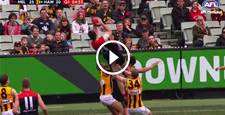For Laura Geitz the brief is simple: fill the shoes of Liz Ellis. Tough brief.
For Laura Geitz the brief is simple: fill the shoes of Liz Ellis. Tough brief.
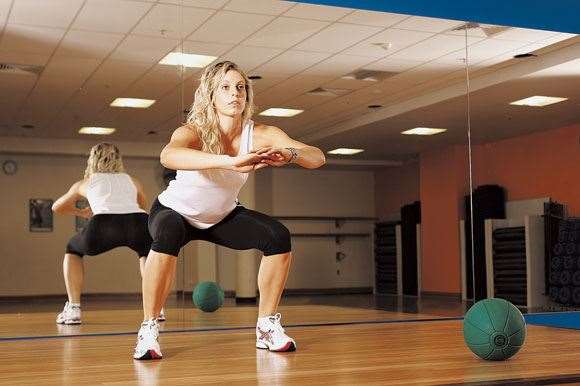 Body weight squats. Images: Trent Mitchell
Body weight squats. Images: Trent MitchellVery tough brief.After her debut season with the Queensland Firebirds last year, Geitz was handed the Australian goalkeeper’s bib for the second and final Test against the Kiwis in Brisbane. The Diamonds were one-nil down. In the first Test, behemoth Kiwi shooter Irene van Dyk had swept all before her, including Australian GK Bianca Chatfield, landing 29 goals at 94 per cent. The Australians slumped to a five-goal loss and the patina of a World Championship seemed to be fading. But in that second Test, Geitz and Mo’onia Gerrard smothered van Dyk, pestering her every move. She finished with just 20 goals at 83 per cent and the Diamonds levelled the series with a two-goal victory. It seems that Geitz, 186cm tall and just 21 years old, is delivering on her brief. But before she slips back into the green and gold lycra, she must navigate another season with the Firebirds in netball’s gleaming ANZ Championship. Last season the Queensland girls began their campaign with a rash of home wins before petering out of finals contention with an abysmal run on the road. Here’s the regime that will reverse that trend this year.
Early Days
“During the pre-season we do two to three court work sessions a week. That’s on-court; ball skills, set plays. These sessions also include a lot of agility work; cone work, agility patterns, just getting our feet used to the speed of the game again. “We also do two weights sessions a week in our own time. We have a program written up by our strength and conditioning coach, James Hood, and it’s highly personalised. James looks at us, judges what our strengths and weaknesses are, then sets up a six to eight week program. So my program will obviously differ a lot from, say, a centre-courter, who runs a lot more. My position revolves around power and strength, whereas theirs would need to be more endurance-based.”
In the Gym
“Our weights program is divided into upper and lower body exercises. I’m doing a lot of bench press and a lot of lat work (lat pull-down and seated row). For my legs, I’m doing dead lifts, squats, lunges. We’re in a very basic, generalised strength stage pre-season. But as we move closer to game day, the program shifts its focus to power work. So, there’s a lot more explosive movements like squat jumps and medicine ball work.“At the moment (pre-season) we’re working on high repetition sets, so I’m looking at three sets of 12 reps for each exercise. But as we progress along the eight-week program, those reps will drop down to, say, three sets of ten, then three sets of seven, and so on. As the reps lower, we’re obviously increasing the weight. “There’s been a much bigger focus this year on increasing our strength. We also do a lot of core work, a lot of Swiss ball work. Obviously with all the changes of direction and taking high balls, we need to have really strong cores so we can stay well balanced on court. We do Swiss ball sit-ups, roll-outs, and bridges with our legs on the ball. It’s all about maintaining good shape in the exercise.”
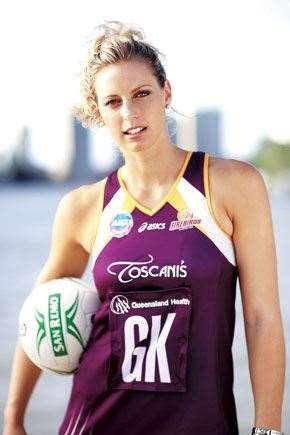 Laura Geitz Queensland Firebirds. Images: Trent Mitchell
Laura Geitz Queensland Firebirds. Images: Trent MitchellBeating the Boys
“For some of our early pre-season trials, we play against the guys – the Queensland men’s team. That’s always a bit of fun. There’s always a bit of extra physicality there … But it’s actually very good. For the past two seasons, they’ve been more than keen to come along and have a bit of a crack at us. Obviously the guys are naturally so much more athletic, so they come out of nowhere and pluck these balls out of the sky and we think, “How did you do that?” They beat us last year, but this year they’re not looking all that good. We played a game a couple of weeks ago and beat them.”
On-Court
“We normally begin our on-court sessions with stock standard drills. These might involve a four corners drill, where the two diagonal corners run towards one another feeding the ball off their left. It’s mainly about switching on, but simple drills like that also hone your placement of the ball and your knowledge of where other girls like their passes. You know, some girls like the ball right out in front of them, while others may not like the reach. So you need to develop an understanding of where the other girls in your team like the ball placed.“After that we’ll often pair-up, one ball between two, and do a lot of short, little drills, one person working for 30 seconds and then switching over. We’ll normally do around five sets of 30 seconds on. That’s all about getting your feet moving and your legs warm for the start of the session.”
Agile Feet
“At the moment our agility work is centred around conditioning. We’ve usually got three agility circuits set up and we rotate through each drill. The drills are fairly standard, using cones and bendable sticks to create gates and markers we have to run through. We might have to run up to a gate and work at double dodging and we’ll do that three times, say, before exploding out to another marker. We’ll then move to the next agility pattern, which might be a four-point drill, involving four markers laid out in a square shape, or the T-drill, where we run up to a marker, run back, then work sidesteps off both legs, before turning and sprinting back. It’s all about repeating the movements we do on court. “Gradually, as the season gets closer, we’ll introduce a ball, adding reactive work into the drills. At the moment we’ll do three minutes on each drill with a small recovery break in between, so it’s very much a fitness circuit while also targeting our agility. Of course, that’s what netball is: short, sharp movements followed by a period of recovery.“We also do a lot of plyometric work; a lot of jumping and bounding. It’s strength and power oriented – particularly important for the defenders and goalers, who do a lot of jumping.”
Set Plays
“Once the aerobic base that’ll carry us through the season is in place, the sessions are far more concentrated, centred around the set plays we’re looking to run during a game. So the shooters, defenders and the centre-courters will all go off into specialised sessions. As a defender, I obviously do most of my work in the circle, working on my combinations with the other defenders, working on getting our communication, our tactics, our different plays coordinated. It’s all very role-specific. “Then we’ll develop that into team runs. So we’ll work within a half court, condensing the game. The attackers can work at bringing the ball down, giving them a chance to set up their plays coming out of the circle, while the centre-courters can work on their touch, feeding the ball into the circle, while the defenders can combat the attackers’ style of play in the circle. Half-court games are a very intense exercise because you just don’t get a break. It’s also a great way of refining ball skills.”
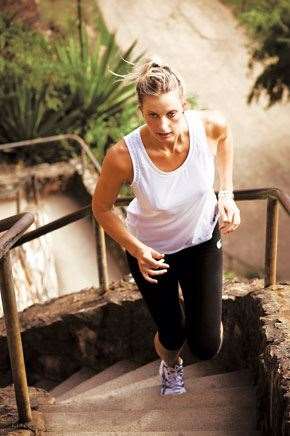 Geitz’s and her fellow Firebirds’ preparation has them edging closer to glory ... step by step. Images: Trent Mitchell
Geitz’s and her fellow Firebirds’ preparation has them edging closer to glory ... step by step. Images: Trent MitchellKnees and Ankles
“When it comes to netball, everyone just says, ‘Ouch – knees and ankles.’ And, yes, at a younger level it can be rough because the girls catch the ball and then make such an effort to stop. But once you get a bit older, you can run-off with a pass, as long as your grounded foot doesn’t move. “But there are still a lot of knee and ankle injuries. We do a huge amount of proprioception work, balancing or squatting on wobble boards, making sure our quads, calves and hammies are strong enough to maintain balance in our joints.“And, of course, before each training session and each game we’ll have our ankles and knees strapped. I never used to strap when I was younger, but now I’ve become so reliant on it. If I don’t strap now, I just think, ‘My goodness. This is scary.’ You feel so fragile. Some people say we rely too much on our strapping and our ankles get weak as a result. But I don’t really buy into that. I’ve been lucky with my knees and ankles so far in my career. Touch wood …”
Food Watch
“We have a great nutritionist who also works with the national team, the Diamonds – Kerry Leech. She’s awesome. She comes in often to take our skinfolds – to measure muscle to fat ratios – to see where we’re at physically. Everything’s monitored.“We don’t actually follow a strict diet plan, it’s more up to you as a professional athlete to be wary of what you’re putting into your body. And if you’re training so hard, then obviously you want to reap the rewards, so eating properly tends to be automatic. But if you’re concerned about your diet, there’s certainly help there: you can have Kerry write you up an eating plan, or you can keep a food diary and she can monitor your intake that way. Some girls place a huge emphasis on all that, while others don’t pay so much attention. Personally, I tend to find diet a pretty simple thing: keep the carbs up, get the right fats in, drink plenty of water.”
Eye in the Sky
“Particularly when you get to the Australian team, there’s a huge emphasis on video analysis. Every time we take the court against a certain team, we’ll do hours of video analysis on them. Everything’s broken down. It’s amazing what some of these video analysts can bring up. It’s crazy. “We can watch, say, all the long-court movements from a certain game, watching the ball come down from the baseline. Or we can watch centre passes, or we can watch how their shooters are moving in the circle, how their defenders are moving in the circle … It’s a great thing for an athlete. You draw so much information from watching other players like that.”
– Aaron Scott
Related Articles
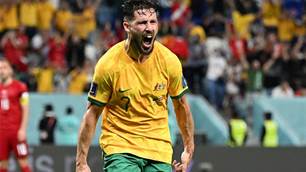
Socceroo star's message to kids: Don't be an AFL player
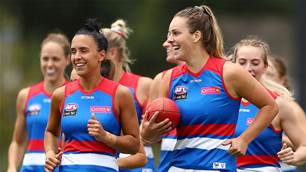
'Be good, or be one of the best...' - The biggest AFLW talking points
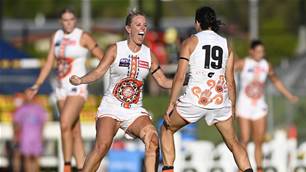





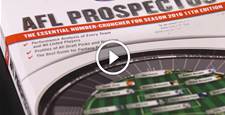
.jpg&h=115&w=225&c=1&s=1)
